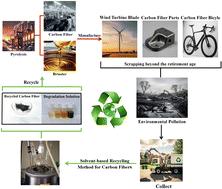通过β-苯乙醇/TBD催化体系回收酸酐固化环氧树脂基碳纤维增强复合材料
IF 9.2
1区 化学
Q1 CHEMISTRY, MULTIDISCIPLINARY
引用次数: 0
摘要
碳纤维增强聚合物(CFRPs)以其优异的力学性能得到了广泛的应用。然而,其热固性树脂基体回收的固有困难导致了严重的环境污染和资源浪费,成为阻碍cfrp可持续发展的主要瓶颈。在本研究中,通过构建由β-苯乙醇和1,5,7-三氮杂环[4.4.0]十二-5-烯(TBD)组成的协同催化体系,开发了一种绿色高效的化学回收策略,使酸酐固化环氧基cfrp在温和条件下(190℃,常压)快速降解。通过优化催化剂与复合材料的质量比[TBD: CFRP (wt: wt) = 1:3 .27],在2小时内实现了几乎完全的树脂降解(>99%)。回收的碳纤维保持了原来单纤维拉伸强度的93.2%。x射线光电子能谱(XPS)和x射线衍射(XRD)分析证实,与原始纤维相比,再生纤维的表面化学功能和石墨化程度没有明显的恶化。这项工作为热固性cfrp的闭环回收提供了一种简单、高效、环保的解决方案。本文章由计算机程序翻译,如有差异,请以英文原文为准。

Recycling of anhydride-cured epoxy resin-based carbon fiber-reinforced composites via a β-phenethyl alcohol/TBD catalytic system
Carbon fiber-reinforced polymers (CFRPs) are widely applied due to their outstanding mechanical properties. However, the intrinsic difficulty in recycling their thermoset resin matrix has led to serious environmental pollution and resource waste, becoming a major bottleneck hindering the sustainable development of CFRPs. In this study, a green and efficient chemical recycling strategy was developed by constructing a synergistic catalytic system composed of β-phenylethanol and 1,5,7-triazabicyclo[4.4.0]dec-5-ene (TBD), enabling the rapid degradation of anhydride-cured epoxy-based CFRPs under mild conditions (190 °C, atmospheric pressure). By optimizing the mass ratio of the catalyst to the composite material [TBD : CFRP (wt : wt) = 1 : 3.27], nearly complete resin degradation (>99%) was achieved within 2 hours. The reclaimed carbon fibers retained up to 93.2% of their original single-fiber tensile strength. X-ray photoelectron spectroscopy (XPS) and X-ray diffraction (XRD) analyses confirmed that no significant deterioration occurred in the surface chemical functionalities or the degree of graphitization of the reclaimed fibers compared to the pristine ones. This work offers a simple, efficient, and environmentally friendly solution for the closed-loop recycling of thermoset-based CFRPs.
求助全文
通过发布文献求助,成功后即可免费获取论文全文。
去求助
来源期刊

Green Chemistry
化学-化学综合
CiteScore
16.10
自引率
7.10%
发文量
677
审稿时长
1.4 months
期刊介绍:
Green Chemistry is a journal that provides a unique forum for the publication of innovative research on the development of alternative green and sustainable technologies. The scope of Green Chemistry is based on the definition proposed by Anastas and Warner (Green Chemistry: Theory and Practice, P T Anastas and J C Warner, Oxford University Press, Oxford, 1998), which defines green chemistry as the utilisation of a set of principles that reduces or eliminates the use or generation of hazardous substances in the design, manufacture and application of chemical products. Green Chemistry aims to reduce the environmental impact of the chemical enterprise by developing a technology base that is inherently non-toxic to living things and the environment. The journal welcomes submissions on all aspects of research relating to this endeavor and publishes original and significant cutting-edge research that is likely to be of wide general appeal. For a work to be published, it must present a significant advance in green chemistry, including a comparison with existing methods and a demonstration of advantages over those methods.
 求助内容:
求助内容: 应助结果提醒方式:
应助结果提醒方式:


